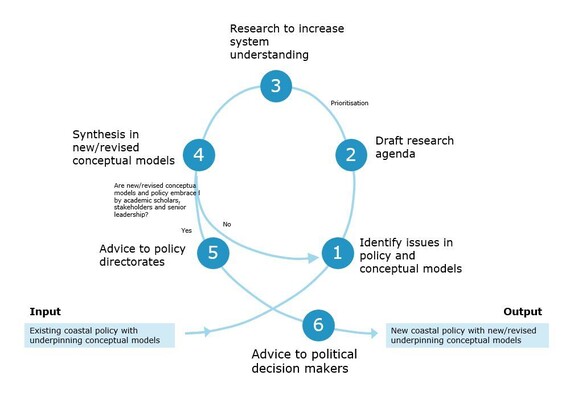Q.J. Lodder11,2, J.H. Slinger2 , Z.B. Wang2,3
1 Rijkswaterstaat; 2 Delft University of Technology; 3 Deltares
Quirijn.Lodder@rws.nl
Introduction
Many of us work on our coast on a daily basis. We draft research proposals, do research, write papers and reports, and teach new generations of coastal scientists, practitioners and policy makers. Often our aim is to advance on all aspects: deliver great science, robust policy, and innovative practice. However achieving this is difficult, especially achieving impact on policy and practice from science. Achieving impact on policy and practice requires bringing together science and policy in a meaningful and effective way. Connecting science to policy is seen, not without reason, as one of the top challenges for sustainability in the 21th century (UNEP, 2012). In the Dutch situation, however, there is a long history within Coastal Flood and Erosion Risk Management of an established link between science and policy. This makes the Dutch policy-driven research approach an intriguing object of study.
Objective and Methods
Case Study Coastal Genesis 2. At present the Dutch coast is maintained using a dynamic conservation strategy (also referred to as dynamic preservation), developed using the results from the Coastal Genesis (Kustgenese) research programme from the nineteen eighties and –nineties. With accelerating sea level rise this management strategy could require a significant increase in nourishment volumes in the future, raising questions regarding the sustainability of the strategy. Accordingly, Rijkswaterstaat initiated the Coastal Genesis 2 (Kustgenese 2) research programme in 2015 aimed at developing a robust and sustainable long-term coastal management strategy. We analyse the policy-driven Coastal Genesis 2 research programme, identifying the process that was followed in its initiation, in determining the research agenda and in synthesizing and communicating the results. We assess the role that conceptual models play in achieving impact on policy and practice (Figure 1).
Results
Our analysis highlights that synthesising new scientific insights into shared conceptual models is critical to achieving impact in policy and practice. In the context of Coastal Genesis 2, a new shared conceptual model of the long-term sediment demand of the Dutch coast enabled the development of potential nourishment strategies. In 2021, the Minister of Infrastructure and Water Management officially articulated her intention to adopt the advised nourishment strategy from 2024 onwards in a letter to parliament.

Figure 1: The ‘Research for Policy’ cycle to support coastal policy development in the Netherlands (Lodder and Slinger 2022) CC 4.0
References
UNEP, 2012. 21 Issues for the 21st Century: Result of the UNEP Foresight Process on Emerging Environmental Issues. United Nations Environment Programme (UNEP), Nairobi, 56 pp.
Lodder, Q.J., Slinger, J.H. 2022. The ‘Research for Policy’ cycle in Dutch coastal flood risk management: The Coastal Genesis 2 research programme. Ocean & Coastal Management 219, 106066. https://doi.org/10.1016/j.ocecoaman.2022.106066.


